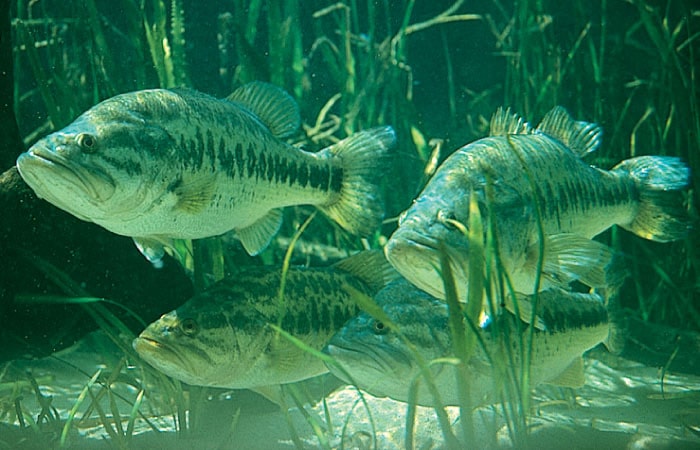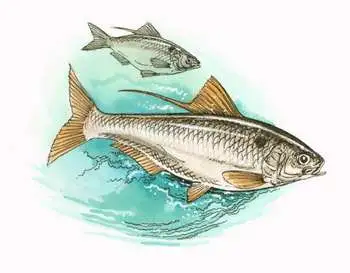Table of Contents
Toggle
When do bass start biting in the spring?
If you are the type of bass angler that waits out the cold winter, this is a very common question.
Although bass never truly stop eating, the springtime certainly ramps up their feeding habits and aggression.
Bass are cold blooded creatures. So in the winter season, bass become less active so that they don’t burn too much energy.
As a result, they lose a lot of body weight during the cold months. Once bass feel that the temperatures are rising they realize that they need to hurry up and eat to prepare for the spawn.
Spawning requires a lot of time and energy for bass, so they need to put on as much weight as they can before spawning time.
45-50 degrees is the range that is warm enough for bass to move around freely while also having enough time to prepare for the spawn.
You are probably thinking that small ponds will warm up to 50-55 degrees much faster that big lakes.
The real answer is yes and no. It is true that smaller bodies of water warm up faster than big ones, but they also get much colder during the winter.
The temperature of a huge lake will not change as much in the winter as a small pond.
So a huge lake might drop to 45 degrees in the winter, while a small pond could get as low as 35 degrees.
Simply put, small ponds warm up faster, but have to warm up from a much lower temperature.
As a result, water temperatures will roughly reach the 50-55 degree mark at the same time as long as they are in the same general location.
The exact time of year that bass will start biting is completely determined by geological location.
The closer to the equator you are, the sooner bass will become active and start eating.
The chart below shows when bass start becoming active based on where you are in the United States.
The “cold water” and “pre-spawn” (or #9 and #1) phases of the chart are when bass will start biting in the spring.

Bass will start biting between late January to late March depending on where you lie on this chart.
Also read: Late Winter Early Spring Bass Fishing
Bass have a limited diet in these early months when the water is still cold. The bluegill and sunfish are still inactive and hiding away in deep waters.
All of the baby bass from last year’s spawn have grown too big to easily eat. The weather hasn’t gotten warm enough for frogs to come out of hibernation.
And there not insects floating on or falling into the water. Bass have two main options during the early spring months. These crawfish and shad.

Crawfish are freshwater crustaceans and can handle colder temperatures. Because of this, crawfish become active a bit earlier than many other species.
Bass eat tons of crawfish in the springtime and you will often find a red coloration on the lips and teeth of springtime bass because of all the crayfish they have been eating.
Crawfish imitation lures are create ways to catch these bass.

Shad are the other side of the coin when it comes to cold water. Shad can not handle the cold water very well.
So when bass art trying to bulk up for the spawn, they feed on tons of dying shad that could not make it all the way through the cold winter.
Bass need little to no effort to feast on these dead or dying shad, making them a favorite in the cold spring months.
This can be the best time to fish for bass. Since bass are primarily feeding on crawfish and shad, you want to use lures that mimic crawfish and shad.
When using the following spring bass lures, keep your colors centered around either red and brown (for crawfish) or grey, silver, and white (for shad).
Suspending Jerkbaits – Imitating Injured Prey: These lures mimic injured baitfish with suspending action, triggering reaction bites. Use sharp jerks followed by pauses to imitate vulnerable prey movements.
Lipless Crankbaits – Vibrant Allure: Emitting vibrations and rattles, these lures excel in murky waters. Vary your retrieve to locate active bass.
Blade Baits – Flash and Vibration: Flashing and vibrating like dying shad, blade baits are perfect for vertical presentations in deep, open waters.
Jigs with Craw Trailers – Crawfish Charm: Pair jigs with crawfish trailers to replicate a favored meal. Drag or hop them for a natural crawfish crawl.
Finesse Worms – Subtle Enticement: Rig finesse worms for a subtle presentation that appeals to cautious bass, especially in cooler waters.
Twitched Soft Plastics – Tempting Twitching: Jerk soft plastics like flukes to imitate injured baitfish. Ideal for targeting suspended bass.
Q1: Why do bass become more active in the spring? A: Bass are cold-blooded creatures, and during the winter, they become less active to conserve energy. As temperatures rise in the spring, bass realize the need to eat and put on weight before the spawning season, which requires a significant amount of time and energy.
Q2: Do small ponds warm up faster than big lakes in the spring? A: Yes, smaller bodies of water generally warm up faster than larger ones. However, small ponds also get much colder during the winter. Despite warming up faster, they start from a lower temperature. In the same general location, both small ponds and big lakes may reach the 50-55 degree mark around the same time.
Q3: When can I expect bass to start biting based on my location? A: The exact timing of when bass start biting in the spring is determined by your geographical location. Closer proximity to the equator results in earlier bass activity. Refer to the provided chart to get an idea of when bass become active in different regions of the United States, typically between late January and late March.
Q4: When is the best time to fish for bass in the spring? A: The prime time for bass fishing in the spring is typically from February to March when water temperatures reach 50-55 degrees Fahrenheit. During this period, bass are active, preparing for the spawn, and feeding on crawfish and shad. Use appropriate lures that mimic these prey for successful spring bass fishing.
Bass typically start biting from February to March once the water temperatures have reached 50-55 degrees Fahrenheit.
Bass start eating at this time because the water is warm enough that they aren’t in danger of losing too much energy while moving around, and they still have enough time before they need to start their spawn.
Bass mostly feed on crawfish and shad during this time period. So when you are fishing in the spring, use red crawfish imitations and silver shad imitations.
